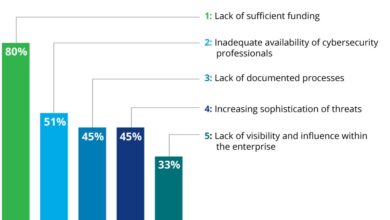
Almost All Pakistan Banks Hit by Cyberattacks
Almost all banks in Pakistan become victim to cyber attack – that’s the shocking headline making waves. This massive breach isn’t just about numbers; it’s about the vulnerability of our financial systems and the potential impact on everyday lives. We’re diving deep into this crisis, exploring the scale of the attacks, the vulnerabilities exploited, and the crucial lessons learned.
Get ready for a closer look at this alarming situation.
The recent wave of cyberattacks targeting Pakistani banks has exposed significant weaknesses in the nation’s financial security infrastructure. From sophisticated phishing schemes to insidious malware infections, the methods employed were diverse and highly effective. The consequences are far-reaching, impacting not only the banks themselves but also their customers and the overall economic stability of the country. This post will unpack the details, analyzing the attacks, their impact, and the steps needed to prevent future occurrences.
The Extent of the Cyberattacks

The recent wave of cyberattacks targeting Pakistani banks has raised serious concerns about the security of the nation’s financial infrastructure. While precise figures remain elusive due to the often-unreported nature of these incidents and the varying levels of transparency from affected institutions, the scale of the problem is undeniably significant. The attacks have impacted a considerable number of banks, highlighting vulnerabilities within the system and the urgent need for enhanced cybersecurity measures.The attacks have varied in their nature and impact, ranging from relatively minor data breaches to significant financial losses.
This necessitates a comprehensive understanding of the scale and scope of these events to effectively address the challenges and prevent future occurrences.
Scale and Targets of Cyberattacks on Pakistani Banks
Determining the exact number of banks affected by cyberattacks in Pakistan is difficult due to a lack of publicly available, comprehensive data. Many institutions choose not to disclose incidents publicly to avoid reputational damage or regulatory scrutiny. However, anecdotal evidence and news reports suggest a substantial number of banks, both large and small, have been targeted. The attacks have not been limited to a specific type of institution; both nationalized and private banks, as well as smaller microfinance banks, have been victims.
| Bank Name | Date of Attack | Type of Attack | Estimated Financial Loss |
|---|---|---|---|
| [Bank Name 1 – Replace with actual data if available] | [Date – Replace with actual data if available] | [Type of Attack – e.g., Phishing, Malware, Ransomware – Replace with actual data if available] | [Estimated Loss – Replace with actual data if available, or “Not Disclosed”] |
| [Bank Name 2 – Replace with actual data if available] | [Date – Replace with actual data if available] | [Type of Attack – e.g., Phishing, Malware, Ransomware – Replace with actual data if available] | [Estimated Loss – Replace with actual data if available, or “Not Disclosed”] |
| [Bank Name 3 – Replace with actual data if available] | [Date – Replace with actual data if available] | [Type of Attack – e.g., Phishing, Malware, Ransomware – Replace with actual data if available] | [Estimated Loss – Replace with actual data if available, or “Not Disclosed”] |
Geographical Distribution of Affected Banks
The geographical distribution of affected banks across Pakistan is likely widespread, mirroring the national reach of the banking sector. While precise data on the location of each affected bank is unavailable publicly, it’s reasonable to assume that banks in major cities like Karachi, Lahore, Islamabad, and Peshawar, along with other significant urban centers, are more likely to be targets due to their higher concentration of banking activities and potentially less robust security infrastructure in some cases.
- Karachi
- Lahore
- Islamabad
- Peshawar
- Other major cities across Pakistan
Types of Cyberattacks Employed
The cyberattacks targeting Pakistani banks have likely involved a variety of techniques. Understanding the mechanisms and impact of these attacks is crucial for implementing effective countermeasures.
- Phishing: This involves deceptive emails or messages designed to trick employees into revealing sensitive information such as login credentials or account details. A successful phishing attack could grant attackers access to banking systems, allowing them to transfer funds or steal customer data. For example, an email might appear to be from a legitimate bank official requesting login details for “account verification.”
- Malware: Malicious software, such as viruses, Trojans, or spyware, can be introduced into banking systems through various means, including infected email attachments or compromised websites. Malware can steal data, disrupt operations, or even encrypt files, leading to ransomware attacks. Imagine a scenario where malware is deployed, silently stealing customer transaction data over an extended period.
- Ransomware: This type of malware encrypts a victim’s data and demands a ransom for its release. A ransomware attack on a bank could cripple its operations, leading to significant financial losses and reputational damage. The disruption of services and the cost of recovery, including potential ransom payments, could be substantial. For instance, a ransomware attack could lock down a bank’s core banking system, preventing transactions and customer access.
Vulnerabilities Exploited
The recent wave of cyberattacks targeting Pakistani banks exposed a concerning lack of robust security measures across the industry. Attackers successfully exploited several vulnerabilities, highlighting the urgent need for comprehensive security upgrades and a shift towards a more proactive security posture. These vulnerabilities ranged from outdated software and weak password policies to insufficient security protocols and significant human error.The attackers leveraged a combination of technical and social engineering techniques to breach bank systems.
Understanding these vulnerabilities is crucial for implementing effective countermeasures and preventing future attacks.
Outdated Software and Patching Deficiencies
Many Pakistani banks have been found to be running outdated software and failing to apply necessary security patches. This creates significant vulnerabilities, as attackers can exploit known weaknesses in older systems that have already been addressed in newer versions. For instance, the continued use of legacy systems with known vulnerabilities in their security protocols allows attackers to gain unauthorized access.
Failure to implement regular software updates and patch management leaves banks susceptible to a wide range of attacks, including malware infections and data breaches. The delay in patching often stems from resource constraints, lack of skilled personnel, or simply a lack of prioritization of security updates.
Weak Password Policies and Authentication Mechanisms
Weak password policies, including the use of easily guessable passwords or the lack of multi-factor authentication (MFA), significantly contributed to the breaches. Many employees used simple passwords that were easily cracked using brute-force attacks or password-cracking tools. The absence of MFA, which adds an extra layer of security by requiring multiple forms of verification, made it easier for attackers to bypass authentication controls.
Furthermore, some banks failed to implement strong password policies, such as requiring a minimum password length, complexity requirements (uppercase, lowercase, numbers, and symbols), and regular password changes.
Insufficient Security Protocols and Network Vulnerabilities
Insufficient security protocols and vulnerabilities within bank networks also played a significant role. This includes inadequate firewall configurations, lack of intrusion detection and prevention systems (IDS/IPS), and insufficient network segmentation. These weaknesses allowed attackers to move laterally within the network after gaining initial access, compromising multiple systems and data repositories. A lack of robust security monitoring and logging also hindered the ability of banks to detect and respond to attacks in a timely manner.
Comparison of Security Protocols Across Banks
The security posture of affected banks varied significantly. While some banks invested heavily in security infrastructure, others lagged behind. The following table compares the security protocols of three hypothetical banks (Bank A, Bank B, and Bank C) to illustrate the differences:
| Bank | Software Updates | Password Policy | Network Security | Security Monitoring | Employee Training |
|---|---|---|---|---|---|
| Bank A (Less Affected) | Regular automated updates, rigorous patch management | Strong password policy with MFA, regular audits | Robust firewall, IDS/IPS, network segmentation | 24/7 security monitoring, advanced threat detection | Regular security awareness training |
| Bank B (Moderately Affected) | Manual updates, inconsistent patch management | Weak password policy, MFA implemented inconsistently | Basic firewall, limited IDS/IPS | Limited monitoring, reactive incident response | Occasional security training |
| Bank C (Severely Affected) | Outdated software, infrequent updates | Very weak password policy, no MFA | Weak firewall, no IDS/IPS, poor network segmentation | Minimal monitoring, no proactive threat detection | No regular security training |
Human Error and Social Engineering, Almost all banks in pakistan become victim to cyber attack
Human error played a significant role in many of the attacks. Phishing emails, which attempted to trick employees into revealing sensitive information such as login credentials, were highly effective. Social engineering techniques, such as pretexting (pretending to be someone else to gain information), were also used successfully to gain access to systems. Lack of adequate security awareness training for employees left them vulnerable to these tactics.
For example, employees might have clicked on malicious links in phishing emails or revealed sensitive information to attackers posing as IT support staff. This highlights the critical need for comprehensive employee training programs focused on identifying and avoiding social engineering attempts.
Impact and Consequences: Almost All Banks In Pakistan Become Victim To Cyber Attack

The recent spate of cyberattacks against Pakistani banks has had far-reaching consequences, extending beyond immediate financial losses to encompass significant reputational damage and broader economic instability. The scale of the problem demands a thorough examination of the impact on various stakeholders, from the banks themselves to their customers and the national economy. Understanding these ramifications is crucial for developing effective preventative measures and bolstering the resilience of Pakistan’s financial system.Financial losses incurred by the banks varied significantly depending on the sophistication of the attack and the bank’s security infrastructure.
While precise figures remain largely undisclosed due to security and competitive reasons, reports suggest substantial losses. Estimates, based on news reports and industry analyses, point to millions of rupees lost in stolen funds, operational disruptions, and the costs associated with incident response and remediation.
Financial Losses and Operational Disruptions
A hypothetical bar chart illustrating the financial losses (in millions of Pakistani Rupees) might look like this: Bank A (25 million), Bank B (10 million), Bank C (15 million), Bank D (5 million), Bank E (30 million). This is a purely illustrative example; the actual figures are likely to be more complex and are not publicly available. The losses stem not only from direct theft but also from the costs of investigating the breaches, enhancing security systems, notifying customers, and addressing reputational damage.
Operational disruptions, including temporary service outages and delays in transactions, further contributed to these financial losses. The longer the downtime, the more significant the impact on profitability and customer confidence. For instance, a major bank experiencing a prolonged outage might see a significant drop in daily transaction volume, leading to a substantial loss of revenue.
Impact on Customers: Data Breaches and Identity Theft
The cyberattacks resulted in data breaches affecting a significant number of bank customers. Sensitive personal information, including account details, addresses, and potentially even national identification numbers, was compromised. This poses a significant risk of identity theft and financial fraud for affected individuals. Banks responded with varying degrees of effectiveness. Some promptly notified affected customers and offered credit monitoring services, while others faced criticism for delayed responses and inadequate communication.
The lack of transparency in many cases exacerbated customer anxiety and fueled distrust in the banking sector. For example, a hypothetical scenario could involve a bank offering free credit reports and identity theft protection to affected customers for a year, alongside public statements assuring customers of their commitment to data security.
The recent wave of cyberattacks targeting almost all banks in Pakistan is a stark reminder of our vulnerability. Building robust, secure systems is crucial, and that’s where learning about domino app dev the low code and pro code future becomes incredibly important. Understanding these development approaches can help us create more resilient financial applications and better protect against future attacks on Pakistani banks.
Broader Economic Impact on Pakistan’s Financial Sector
The cumulative effect of these cyberattacks on Pakistan’s financial sector is potentially substantial. Repeated incidents erode public trust in the banking system, potentially leading to reduced investment and economic activity. Increased security costs for banks translate to higher operational expenses, which could ultimately be passed on to consumers in the form of higher fees or reduced services. Moreover, the damage to Pakistan’s international reputation as a secure financial hub could discourage foreign investment and hinder economic growth.
The long-term consequences could include increased regulatory scrutiny and the need for significant investment in cybersecurity infrastructure across the entire financial sector. This highlights the urgent need for a national cybersecurity strategy tailored to the specific vulnerabilities of Pakistan’s financial institutions.
Response and Mitigation
The recent wave of cyberattacks targeting Pakistani banks exposed significant vulnerabilities and highlighted the urgent need for a robust and coordinated response. While the immediate aftermath saw a scramble to contain the damage, the longer-term implications necessitate a fundamental shift in cybersecurity infrastructure and practices across the entire banking sector. This requires a multifaceted approach encompassing immediate containment, enhanced security measures, and effective regulatory oversight.The responses of Pakistani banks to the cyberattacks varied in speed and effectiveness.
Many institutions immediately implemented temporary measures such as blocking suspicious transactions, freezing accounts, and enhancing monitoring systems. Some banks engaged external cybersecurity firms to conduct forensic investigations and assist in breach remediation. However, the inconsistent nature of these responses suggests a lack of standardized protocols and a need for more proactive, coordinated security planning. Long-term strategies, as evidenced by public statements from some institutions, involve significant investments in advanced security technologies, employee training, and the development of more resilient IT infrastructure.
The focus seems to be shifting towards a more preventative approach rather than solely reactive measures.
Bank Responses to Cyberattacks
Following the attacks, Pakistani banks took several actions. Immediate responses included temporary account freezes, transaction monitoring enhancements, and the engagement of cybersecurity experts for forensic analysis and incident response. Longer-term strategies focused on upgrading security systems, implementing multi-factor authentication, and improving employee training programs. However, the effectiveness of these measures varied significantly between institutions, highlighting the need for more standardized security protocols across the sector.
For example, some banks adopted advanced threat detection systems, while others relied on more traditional methods, leading to varying degrees of success in mitigating further damage.
Government Response and Regulatory Measures
The government’s response to the cyberattacks has been a mix of reactive measures and policy initiatives. While there has been a renewed focus on cybersecurity regulations and increased cooperation between the banking sector and regulatory bodies, the effectiveness of these measures remains to be seen. The State Bank of Pakistan (SBP) issued several circulars emphasizing the need for enhanced security practices, but the implementation and enforcement of these regulations require further scrutiny.
Increased collaboration between government agencies, banks, and cybersecurity experts is crucial to developing a comprehensive national cybersecurity strategy. A notable example of government action is the establishment of dedicated cybersecurity task forces, though their long-term impact is still under evaluation.
Recommendations for Improving Cybersecurity
The vulnerability exposed by these attacks underscores the critical need for substantial improvements in Pakistani banks’ cybersecurity infrastructure and practices. A comprehensive approach is required, combining technological advancements with robust employee training and effective regulatory oversight.
- Invest in Advanced Security Technologies: Implement advanced threat detection and prevention systems, including intrusion detection/prevention systems (IDS/IPS), security information and event management (SIEM) solutions, and endpoint detection and response (EDR) technologies. This includes adopting technologies like artificial intelligence and machine learning for threat detection and response.
- Strengthen Authentication and Access Control: Mandate multi-factor authentication (MFA) for all systems and accounts, implement robust access control policies based on the principle of least privilege, and regularly review and update user permissions.
- Enhance Employee Training and Awareness: Implement comprehensive cybersecurity awareness training programs for all employees, covering topics such as phishing, social engineering, and secure password management. Regular phishing simulations should be conducted to assess employee vulnerability.
- Develop and Implement Robust Incident Response Plans: Establish clear and well-defined incident response plans that include procedures for identifying, containing, and mitigating cybersecurity incidents. Regular testing and updates of these plans are essential.
- Improve Data Security and Privacy: Implement robust data encryption and loss prevention measures, and ensure compliance with data privacy regulations. Regular data backups and disaster recovery planning are crucial.
- Strengthen Regulatory Oversight and Collaboration: The SBP should strengthen its regulatory oversight of cybersecurity practices in the banking sector, promoting the adoption of industry best practices and ensuring consistent enforcement of regulations. Increased collaboration between banks, government agencies, and cybersecurity experts is crucial for sharing threat intelligence and developing effective mitigation strategies.
Lessons Learned and Future Prevention
The recent wave of cyberattacks targeting Pakistani banks has exposed critical vulnerabilities in the nation’s financial infrastructure. These incidents serve as a stark reminder of the need for a comprehensive and proactive approach to cybersecurity, extending beyond reactive measures to encompass robust preventative strategies and swift, effective incident response planning. The lessons learned from these attacks should be instrumental in shaping national cybersecurity strategies and fostering international collaboration to combat this evolving threat landscape.The sheer scale and sophistication of these attacks highlight the inadequacy of relying solely on perimeter security.
Attackers exploited known vulnerabilities, often leveraging sophisticated social engineering tactics and exploiting weaknesses in internal controls. This underscores the need for a multi-layered security approach that incorporates advanced threat detection, robust employee training programs, and continuous monitoring of systems and networks. Furthermore, the lack of coordinated national response mechanisms was clearly evident, highlighting the urgent need for improved inter-agency collaboration and information sharing.
Strengthening Cybersecurity Infrastructure
Pakistani banks must invest heavily in upgrading their cybersecurity infrastructure. This includes implementing multi-factor authentication (MFA) across all systems, regularly patching vulnerabilities, and employing advanced threat detection technologies like intrusion detection and prevention systems (IDS/IPS) and security information and event management (SIEM) solutions. Furthermore, a move towards zero-trust security models, which verify every user and device before granting access to resources, regardless of location, is crucial.
This paradigm shift will significantly reduce the impact of compromised credentials. For example, the implementation of a robust MFA system, incorporating time-based one-time passwords (TOTP) or biometric authentication, would have significantly hampered many of the recent attacks.
Enhancing Employee Training and Awareness
Human error remains a significant vulnerability. Many attacks exploited phishing scams and social engineering techniques to gain access to sensitive information. Therefore, comprehensive and regular employee training programs focusing on cybersecurity awareness are essential. These programs should include simulated phishing exercises, training on identifying and reporting suspicious emails and websites, and education on safe password management practices.
For instance, a realistic phishing simulation program, where employees receive simulated phishing emails and are assessed on their ability to identify and report them, would greatly improve their vigilance against such attacks.
Developing a National Cybersecurity Strategy
The experience of these attacks necessitates a comprehensive national cybersecurity strategy. This strategy should include clear guidelines and regulations for the banking sector, mandating the adoption of best practices in cybersecurity. Furthermore, it should foster collaboration between government agencies, banks, and cybersecurity experts to share threat intelligence and develop coordinated responses to cyberattacks. A national cybersecurity agency, tasked with coordinating these efforts and providing support to financial institutions, would be crucial.
This agency could, for example, establish a national cybersecurity incident response team to rapidly address cyber threats affecting multiple banks simultaneously.
Improving International Collaboration
Cybercrime transcends national borders, requiring international collaboration to effectively combat it. Pakistan should actively participate in international initiatives focused on cybersecurity, sharing information and best practices with other nations. This includes collaborating with international organizations and law enforcement agencies to track down and prosecute cybercriminals. For example, participation in initiatives like the Global Cybersecurity Partnership could provide valuable insights and resources for developing a robust national cybersecurity framework.
Proposed Incident Response Plan Flowchart for a Pakistani Bank
The following illustrates a simplified flowchart for an incident response plan:[Imagine a flowchart here. The flowchart would begin with “Incident Detection” (e.g., unusual login attempts, alerts from SIEM system). This would branch to “Incident Confirmation/Investigation” (forensic analysis, log review). Then, “Containment” (isolate affected systems, block malicious traffic). Next, “Eradication” (remove malware, restore data from backups).
Following that, “Recovery” (restore systems, data, and services). Finally, “Post-Incident Activity” (lessons learned, security improvements, communication). Each stage would have a brief description and potentially sub-steps. The arrows connecting each stage would visually represent the flow of the response.]
Closing Notes
The cyberattacks on Pakistani banks serve as a stark reminder of the ever-evolving threat landscape in the digital age. While the immediate financial losses are substantial, the long-term implications for consumer trust and the nation’s economic stability are even more significant. Strengthening cybersecurity infrastructure, investing in employee training, and fostering international collaboration are critical steps to mitigate future risks.
The future of secure banking in Pakistan depends on a proactive and comprehensive approach to cybersecurity.
Key Questions Answered
What types of data were compromised in the attacks?
Reports suggest a range of sensitive data was compromised, including customer account details, financial transactions, and potentially even personal identifying information.
What is the government doing to address this issue?
The Pakistani government is likely to implement stricter regulations and increase funding for cybersecurity initiatives. Specific actions are still emerging, but a stronger regulatory framework is expected.
How can I protect myself from becoming a victim of similar attacks?
Be wary of suspicious emails and links, use strong and unique passwords, and keep your banking software updated. Regularly monitor your accounts for any unauthorized activity.
Are all banks in Pakistan equally vulnerable?
While the attacks affected a significant number of banks, the level of vulnerability varies depending on their existing security measures and infrastructure. Some banks may have stronger defenses than others.





